With billions of searches made on Google every day, ranking on the first page isn’t just a vanity metric—it’s a game-changer for traffic, visibility, and conversions.
But ranking higher on Google isn’t about shortcuts or quick hacks.
It requires a strategic, long-term approach that aligns with Google’s mission: delivering the most helpful and relevant results to the audience. From optimizing your content and improving site speed to earning high-quality backlinks and enhancing user experience, every detail matters.
To navigate this competitive space, you need a well-rounded SEO strategy that includes on-page optimization, off-page techniques, technical excellence, and a keen focus on user experience.
In this post, we’ll discuss how to rank higher on Google. So, without any further ado, let’s get started.
Table Of Contents
1 What is Google Ranking?
Google ranking refers to the position your website or webpage appears on Google’s search engine results pages (SERPs) for a given search query.
When someone searches on Google, the search engine scans billions of web pages using a complex algorithm to deliver the most relevant and reliable results. These results are then ranked based on relevance, authority, and several other factors, aiming to present the user with the most appropriate answer.
A page’s position in search results is influenced by many ranking factors. Some of the most important include:
- Relevance: How closely your content matches the search query, based on keywords and related terms.
- Content Quality: High-value, in-depth, and well-structured content tends to perform better in search rankings.
- Backlinks: Links from other trustworthy websites serve as endorsements, signaling authority to Google.
- User Experience: Fast-loading pages, mobile responsiveness, and positive engagement metrics (like time on page) contribute to higher rankings.
- Technical SEO: Proper use of meta tags, headers, sitemaps, and crawlable site architecture helps search engines understand and index your content.
By understanding how these elements work together, you can create a strong SEO foundation that helps improve your Google rankings and attract more organic traffic.
Refer to our detailed guide on the top 15 Google ranking factors to understand them and achieve and maintain high search engine rankings.
2 How to Rank Higher on Google
Let us now discuss how to rank higher on Google.
2.1 Align Your Content to Search Intent
To rank higher on Google, it’s essential to align your content with search intent—the reason behind a user’s query.
Also known as user intent, search intent reflects what someone hopes to accomplish when typing a keyword into Google.
There are four primary types of search intent:
- Informational Intent: The audience is looking for information or answers to questions. Example: How to grow tomatoes in pots.
- Navigational Intent: The audience intends to find a specific website or page. Example: Facebook login.
- Transactional Intent: The audience wants to purchase or complete a transaction. Example: Buy running shoes online.
- Commercial Investigation: The audience is considering a purchase and is comparing products or services. Example: Best running shoes for women 2026.
To optimize for search intent, start by analyzing the keywords you’re targeting. Look at the top-ranking results—what kind of content do they feature? Is it a guide, product page, review, or tutorial? Your content should mirror that intent.
For instance, if your keyword is how to grow tomatoes in pots, users are likely looking for step-by-step guidance. A detailed blog post that covers choosing pots, selecting the right soil, and caring for tomato plants would directly satisfy their informational intent.
With Rank Math PRO’s Search Intent feature, you can easily align your content with the correct search intent. Just click the Show Intent button next to your focus keyword to instantly see the identified intent—helping you align your content with what users expect.
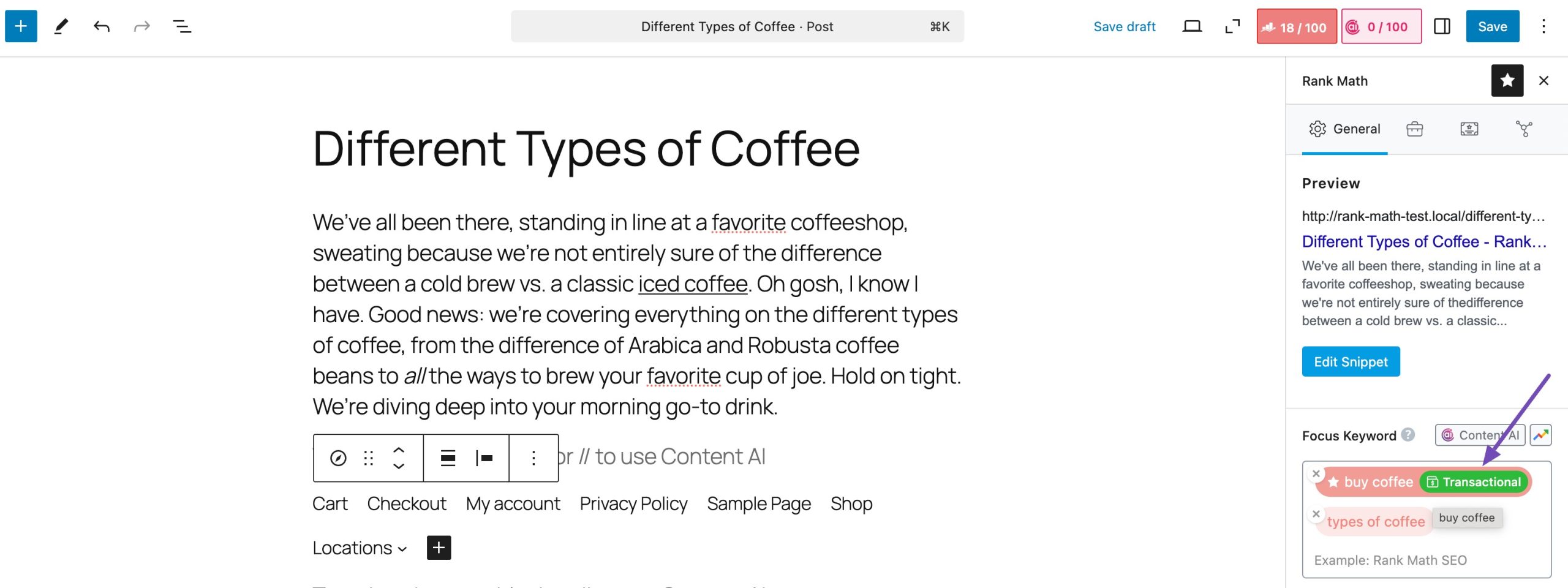
By providing detailed, valuable information that aligns with the audience’s intent, you’ll be more likely to satisfy their needs, keep them engaged, and improve your chances of ranking higher on Google.
2.2 Understand Keyword Basics
Keywords are the foundation of SEO, and understanding how they work is the first step toward ranking on Google.
Keywords are the words or phrases people type into search engines when looking for information. Whether it’s the best smartphones under $500 or how to bake a chocolate cake, these search terms help Google understand what content users want to see.
To rank higher, you need to identify the keywords your target audience is using and incorporate them naturally into your content.
Types of Keywords to Know:
- Short-Tail Keywords: Broad and competitive terms like shoes or marketing. These drive high search volume but are harder to rank for.
- Long-Tail Keywords: More specific phrases like best trail running shoes for women. They have lower competition and often convert better.
- LSI Keywords (Related Terms): These are semantically related words that give context to your main keyword. For example, with digital marketing, related terms might include SEO, content strategy, and social media.
Use keyword research tools like Google Keyword Planner, Rank Math’s Content AI, or Ubersuggest to find relevant keywords with good search volume and manageable competition.
Strategically place keywords in important areas such as titles, headings, meta descriptions, and the first paragraph of your content. Ensure they are relevant to the context of the content.
You can use Rank Math’s Research feature by entering your focus keyword in the FOCUS KEYWORD field and clicking the Research button.
Rank Math will request our AI server to analyze the keyword, and in a few moments, you’ll find the expected word count and the expected number of times the keyword can be used in the content inside your Content AI panel.
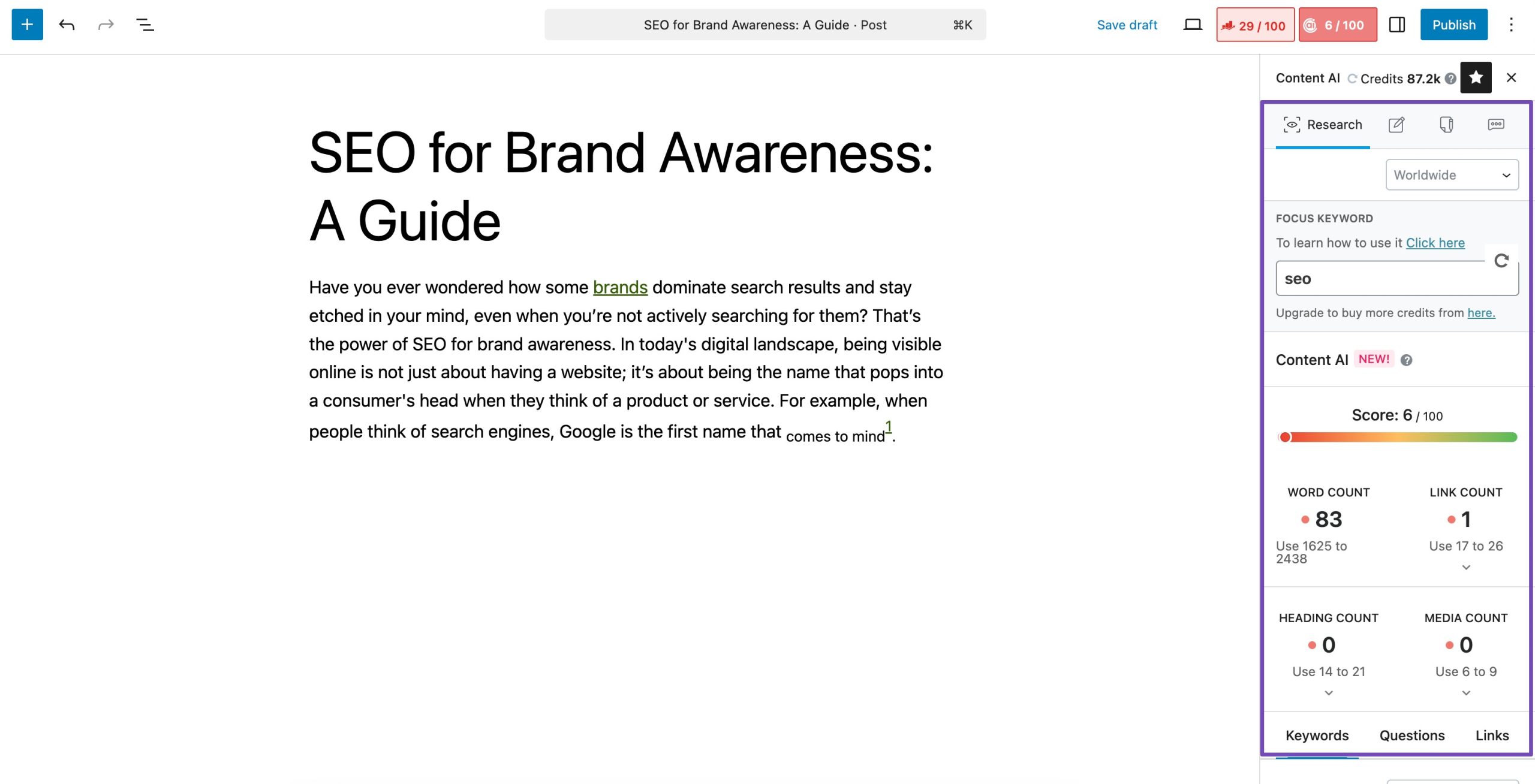
By understanding the basics of keywords and choosing the right ones, you’ll be better equipped to create content that ranks, attracts the right visitors, and drives meaningful results.
Refer to our dedicated tutorial to perform keyword research once you’ve identified your keywords.
2.3 Create High-Quality Content
Creating high-quality content is one of the most effective ways to improve your website’s rankings on Google. It not only captures and retains the attention of your audience but also signals to Google that your content is valuable, relevant, and trustworthy.
Google places a strong emphasis on what it calls E-E-A-T signals: Experience, Expertise, Authority, and Trustworthiness.
- Experience – Firsthand knowledge or use of a product or topic
- Expertise – Demonstrated skill or depth in the subject matter
- Authority – Recognition from other trustworthy sources
- Trustworthiness – Reliable, accurate, and honest content
By integrating E-E-A-T principles into your content creation, you enhance its quality and appeal to the audience and search engines, thereby improving your chances of ranking higher on Google.
And here’s a valuable insight from our own research: 47% of users are leveraging AI tools to speed up content production, while 35% are shifting their focus from content quantity to quality.
So, you can use Content AI to create high-quality content that ranks well in search engines. By suggesting relevant keywords, optimizing for readability, and aligning your content with user intent, you ensure your content meets both audience needs and Google’s expectations.
2.4 Improve On-Page SEO
To rank higher on Google, optimizing your on-page SEO is essential. This includes refining your content, structure, and HTML elements to make your pages more relevant and user-friendly.
Firstly, start with keyword optimization. Add the keywords naturally into your page’s title tag, meta description, headers (H1, H2, etc.), and throughout the content. Avoid overstuffing keywords, as this can harm readability and result in penalties from search engines.

Next, optimize your content for readability and user experience. Structure your content using clear headings, subheadings, bullet points, and short paragraphs. Use engaging, descriptive language to keep readers on the page.
To further improve readability:
- Use relevant alt text and optimized file names for media elements
- Add images, videos, or infographics to support your points
Rank Math’s content analysis tests checks whether your focus keyword is present in key areas like the title, subheadings, and meta description, and alerts you if it’s missing.
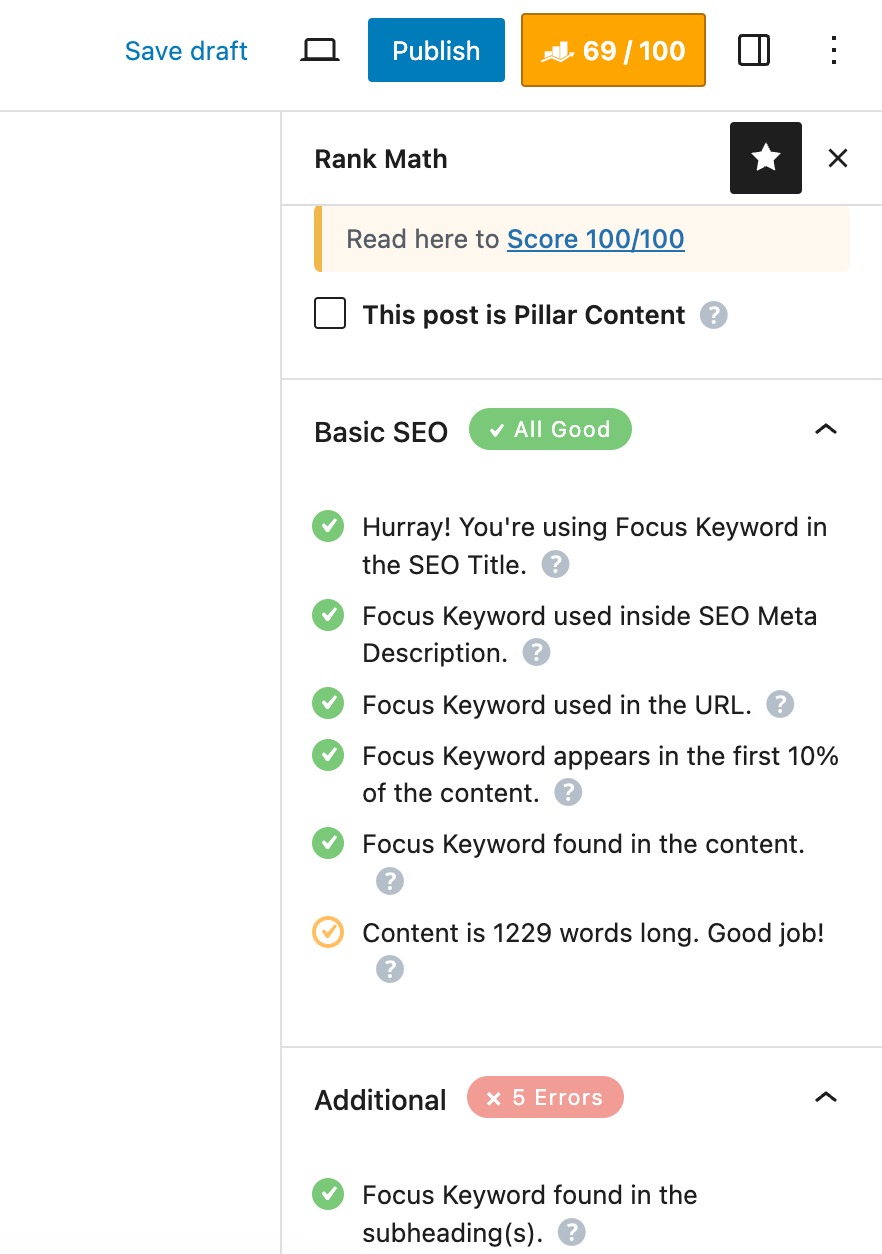
It also flags the absence of images or videos, helping you ensure your content is rich and engaging.
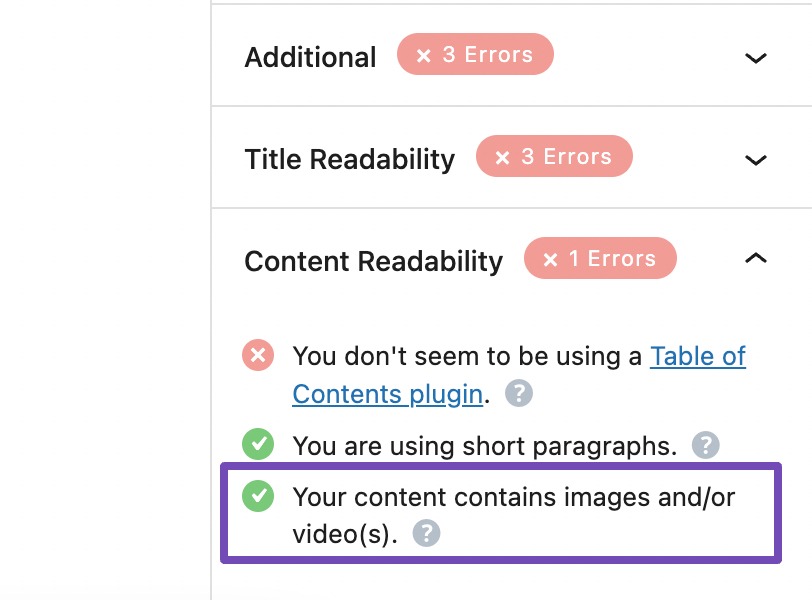
Next, focus on internal linking. Create a logical internal linking structure that helps both the audiences and search engines navigate your site. Link relevant pages and posts together using anchor text that includes relevant keywords.
You can take this further with Rank Math’s Pillar Content feature.
To do so, navigate to the General tab of Rank Math SEO and check the This post is Pillar Content as shown below.
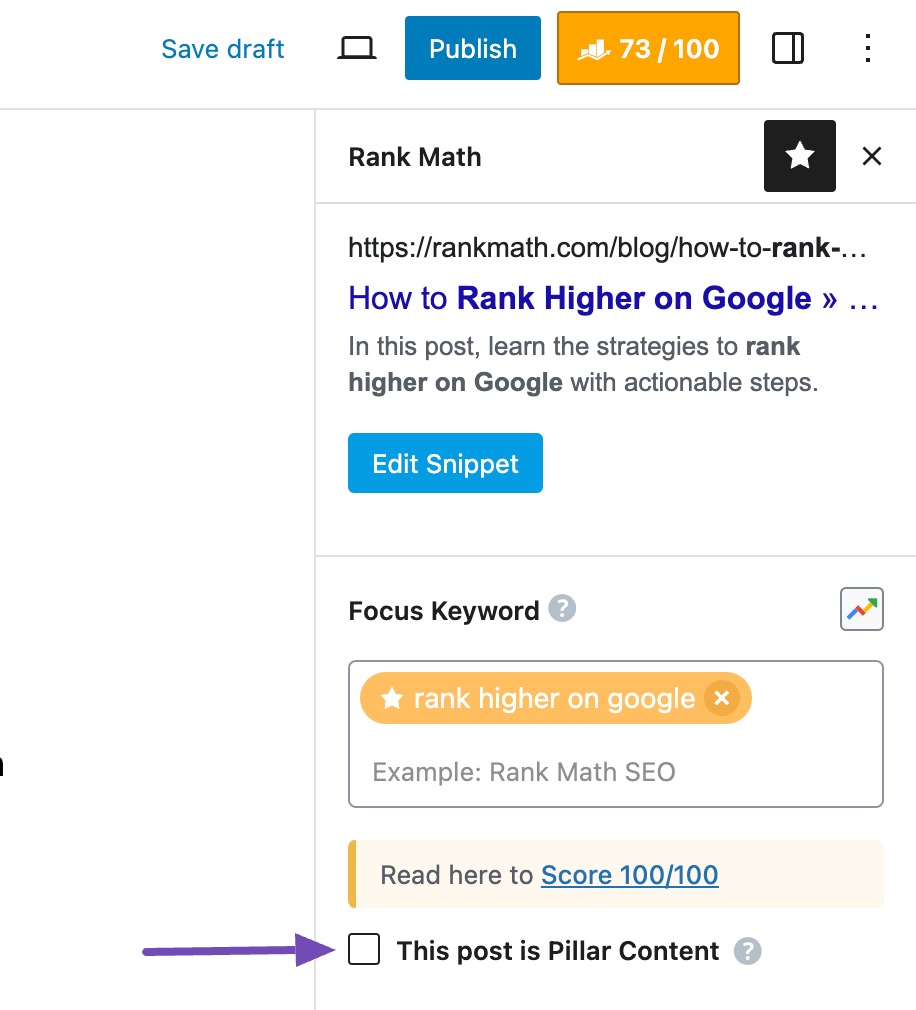
Refer to our dedicated tutorial on on-page SEO to improve your on-page SEO and rank higher on Google.
2.5 Merge Similar Pages
Merging similar or overlapping pages is a smart way to boost your SEO performance and provide a better user experience.
When multiple pages on your site target the same or closely related keywords, they may end up competing with each other in search results—a phenomenon known as keyword cannibalization. This can weaken the performance of each page and confuse both users and search engines.
Instead, by combining these pages into one comprehensive, high-value resource, you create a stronger, more authoritative page that’s more likely to rank well.
In a Webmaster Hangout, Google’s John Mueller explained that merging weaker pages into a single, more useful one can help improve rankings—but only if the new version delivers more value than the individual pages did separately.
For instance, let’s say you run a travel blog and have two separate posts:
- Top 10 Beach Destinations in Europe
- Best European Beaches for Summer Vacation
These pages likely overlap in content and keywords. By merging them into a single, optimized guide, such as The Ultimate Guide to European Beach Destinations, you:
- Eliminate keyword cannibalization
- Create a more useful, in-depth resource
- Increase the authority of a single page instead of splitting it across two weaker ones
This strategy not only helps with SEO but also improves navigation and clarity for your readers.
2.6 Build More Backlinks
Backlinks—links from other websites pointing to your own- are one of Google’s most important ranking signals. When authoritative sites link to your content, it sends a strong signal to search engines that your page is valuable and trustworthy.
In fact, a study by Ahrefs revealed that 96% of all pages get zero organic traffic from Google, and one of the biggest reasons is a lack of backlinks.
To effectively build backlinks, focus on creating content that is worth linking to, such as comprehensive guides, original research, infographics, or unique tools.
Additionally, engage in outreach efforts to promote your content. Identify relevant websites, bloggers, and influencers in your niche and reach out to them with a personalized message, highlighting the value of your content and how it can benefit their audience.
To further enhance your strategy, use our Content AI tool. Within the Content AI dashboard, scroll to the section labeled Links. This section provides a curated list of authoritative and relevant external links based on your target keyword, helping you identify potential sites for outreach or reference.
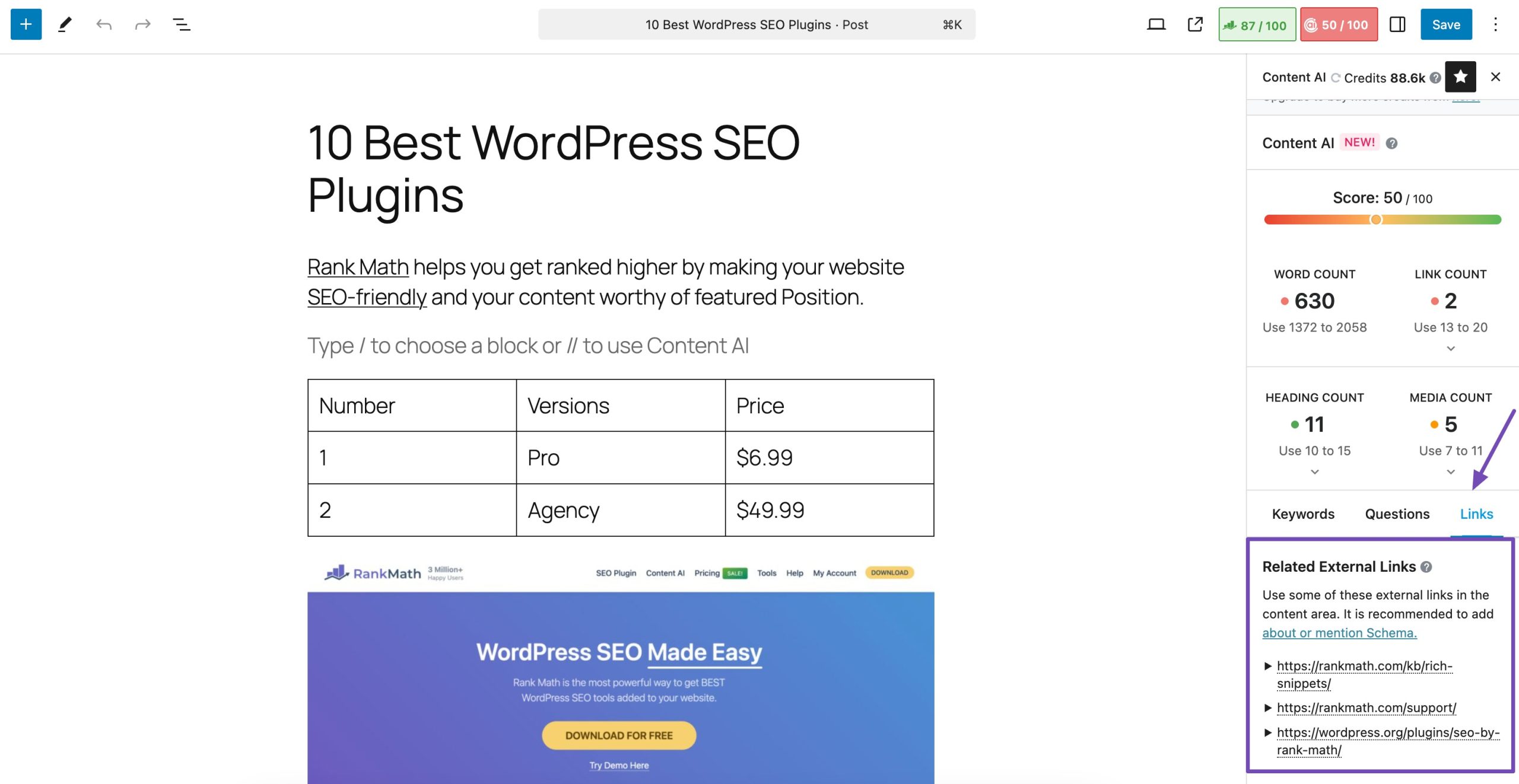
Guest posting on reputable sites is another effective way to earn backlinks. By contributing high-quality articles to authoritative blogs, you can include links to your site, enhancing your backlink profile.
2.7 Fix Broken Links
Broken links, also known as dead links, lead visitors to non-existent pages (typically showing a 404 error). While occasional broken links are common and not a major issue according to Google, a large number of them can negatively affect your website’s rankings and user experience.
When users click on a broken link, they’re met with frustration instead of helpful content. This can increase bounce rates, lower user trust, and reduce your site’s overall authority in the eyes of search engines.
To address this, use the 404 monitor and Redirections feature within the Rank Math SEO plugin and fix these links, ensuring a smoother user experience and potentially improving your search engine rankings.
To do so, navigate to Rank Math SEO → Dashboard → Modules, switch to Advanced Mode, and enable both the 404 Monitor and Redirections modules.
Next, go to Rank Math SEO → 404 Monitor to view a log of all 404 errors on your site. To fix a broken link, hover over it and click Redirect, or select multiple URLs to apply a bulk redirect.
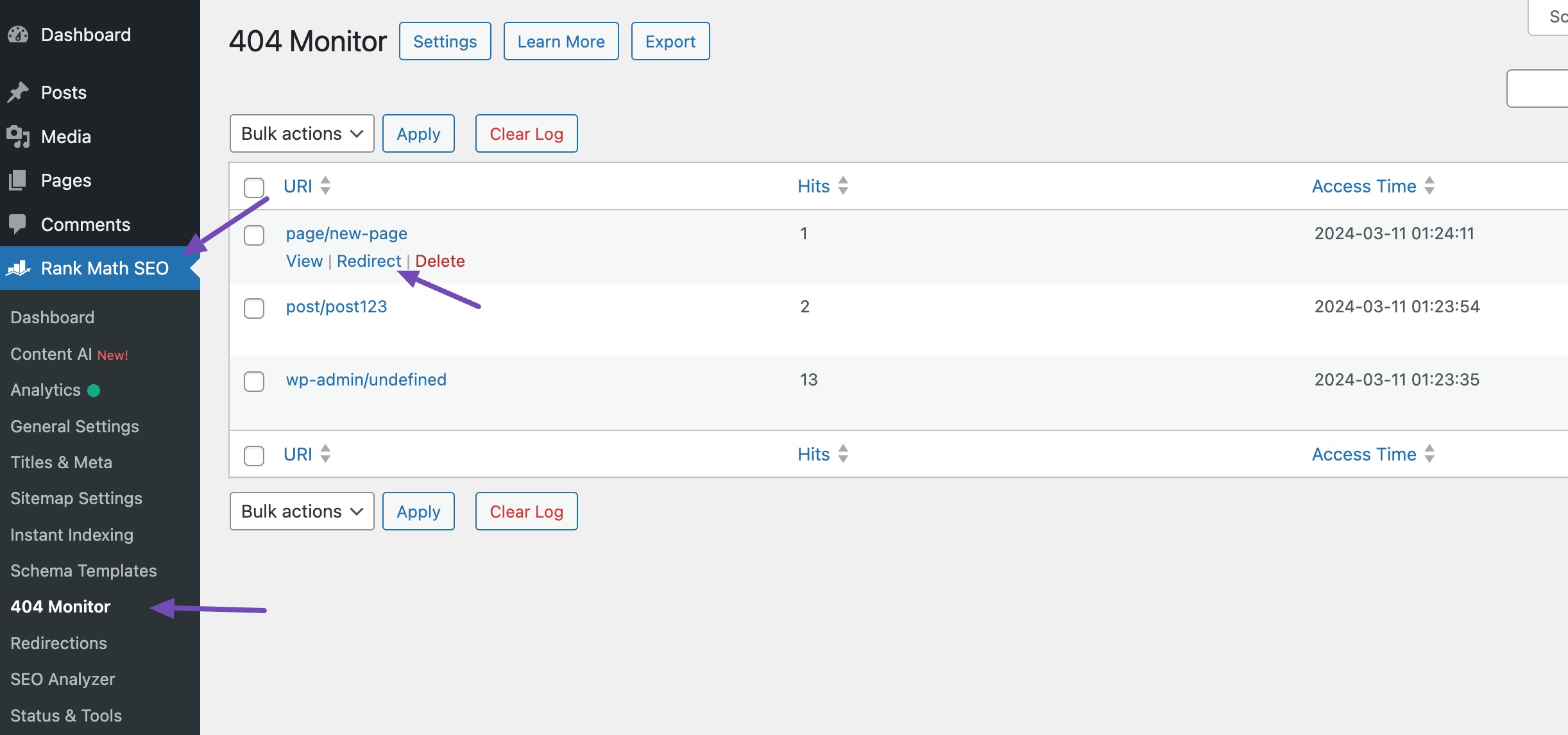
You’ll be taken to the Redirections page. Enter the Destination URL, keep the redirection type as 301 (Permanent Move), and configure optional settings like activation time or category. Then click Add Redirection.
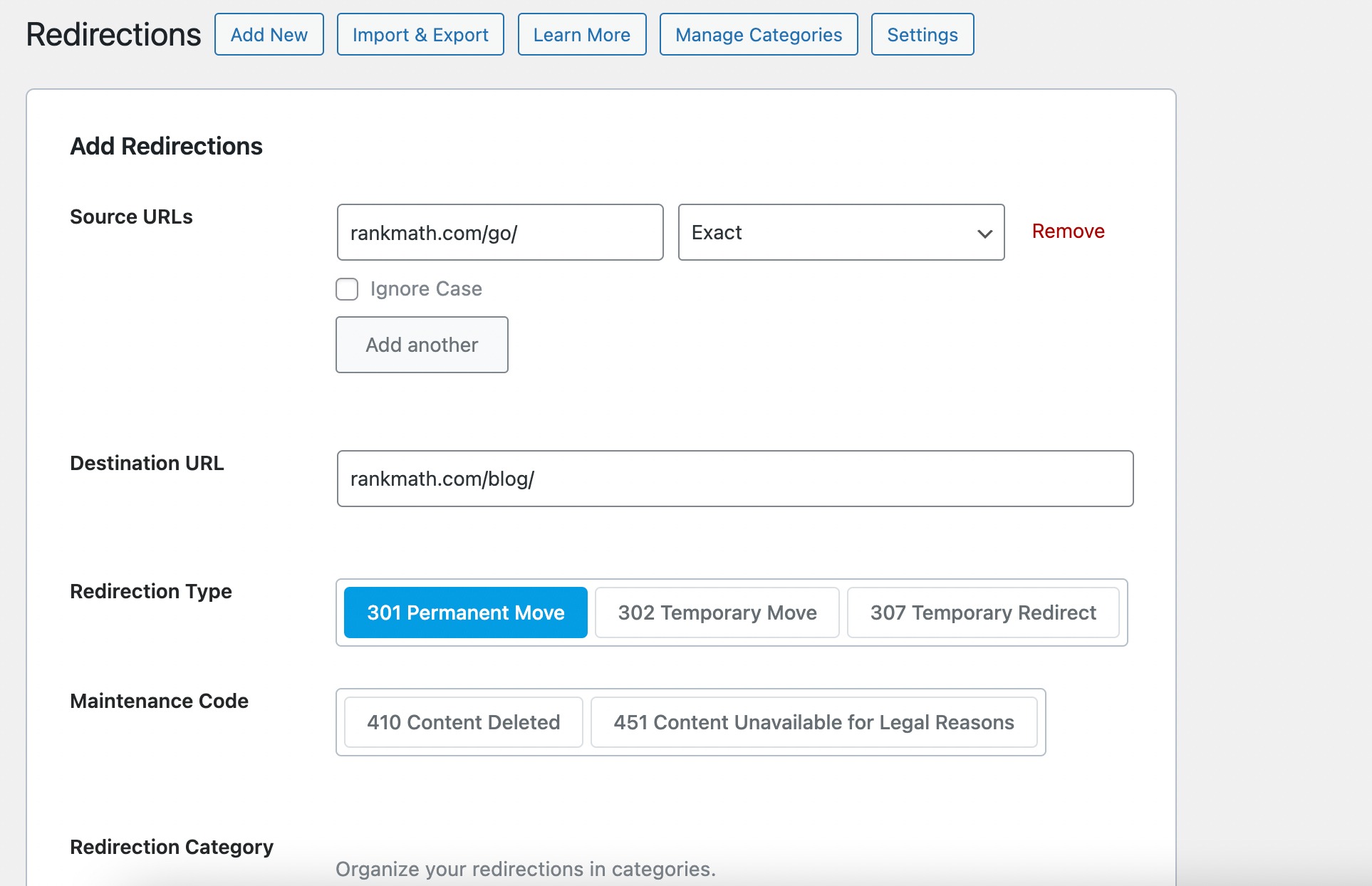
To view and manage existing redirects, go to Rank Math SEO → Redirections.
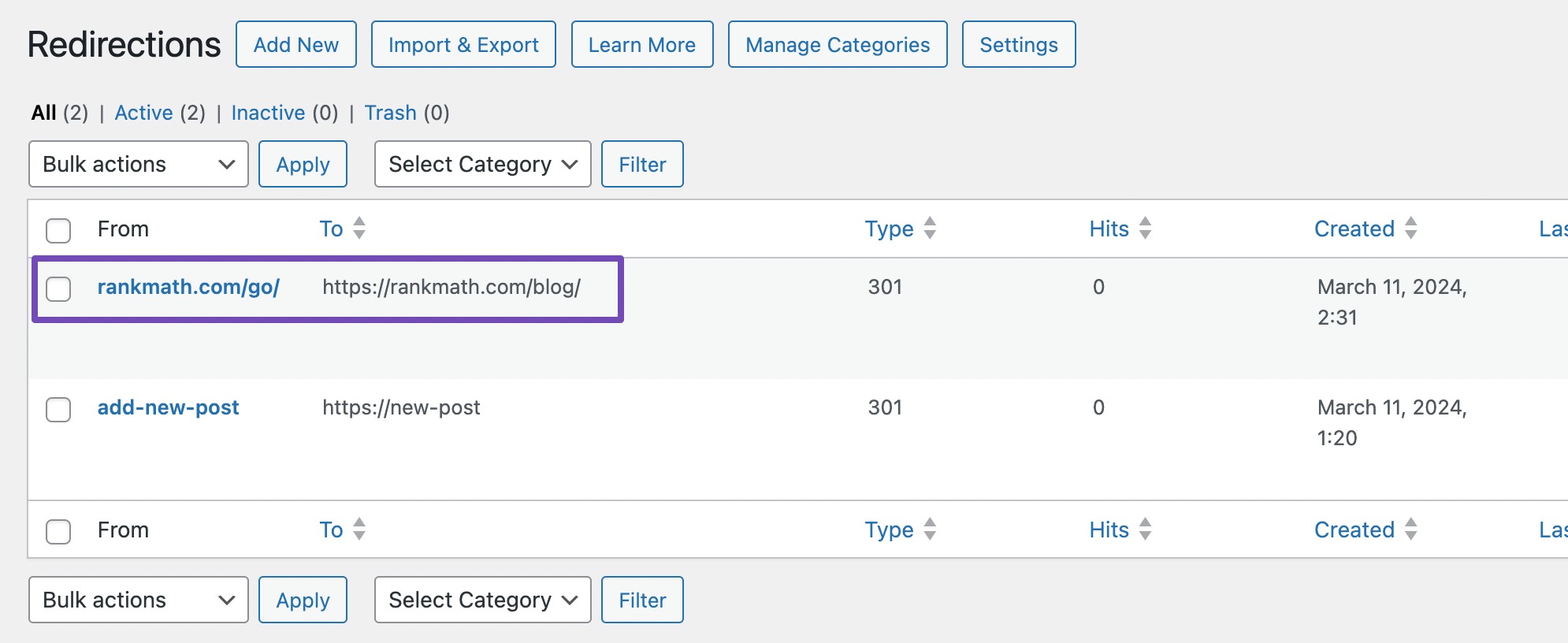
After setting up 301 redirects, update any internal links on your site that pointed to the old URLs. This ensures that the audience and crawlers directly access the correct pages without relying on redirects.
Refer to our dedicated tutorial on finding and fixing broken links in WordPress.
2.8 Improve Page Experience
Google doesn’t just rank content based on relevance; it also considers how users experience your website. A positive page experience can improve your search visibility, reduce bounce rates, and increase engagement.
Page experience goes beyond the content itself. It includes how users interact with your site and how smoothly it performs.
Google evaluates page experience using several key signals:
- Core Web Vitals (loading speed, interactivity, visual stability)
- Mobile-friendliness
- Safe browsing
- HTTPS security
Core Web Vitals are performance metrics that reflect how fast and stable your page feels to users:
- Largest Contentful Paint (LCP): Measures load speed
- Interaction to Next Paint (INP): Measures interactivity
- Cumulative Layout Shift (CLS): Measures visual stability
If your site loads slowly or shifts unexpectedly, users are more likely to leave, hurting both their experience and your rankings.
For instance, if your webpage takes too long to load, your audience is likely to leave, which increases your bounce rate and negatively impacts your ranking. Ensuring your site meets the thresholds for these metrics is essential for a positive page experience.

In our survey, we found 89% of respondents are actively using a performance optimization tool, with WP Rocket leading the pack, trusted by 56% to improve page experience.
With the majority of users browsing on smartphones, Google gives preference to mobile-optimized websites. To ensure a great mobile experience:
- Avoid small text or elements that require zooming
- Use responsive design
- Make navigation intuitive
Google also favors secure websites. Using HTTPS encryption protects user data and builds trust. If your site still runs on HTTP, consider upgrading—it’s a confirmed ranking factor.
Refer to our dedicated tutorial on speed optimization to improve the page experience.
2.9 Track and Monitor Results
Tracking and monitoring your SEO results is essential for continuously improving your website’s ranking on Google. By regularly analyzing performance data, you can identify what strategies are working, pinpoint areas for improvement, and make informed decisions to enhance your SEO efforts.
Use tools like Google Analytics, Google Search Console, and other SEO software like Ahrefs, Semrush, or Moz to gather and analyze data.
Google Analytics helps you understand user behavior on your site, while Google Search Console provides insights into how your site performs in search results and identifies any technical issues.
Refer to our dedicated tutorial to check your Google rankings.
3 Conclusion
Ranking higher on Google doesn’t happen by chance—it requires a strategic mix of planning, high-quality content, technical optimization, and ongoing improvements.
By mastering SEO fundamentals, such as keyword research, search intent, E-E-A-T, and on-page SEO, you can create content that not only ranks well but also keeps users engaged.
Combining these efforts with smart tactics, such as merging overlapping pages, earning authoritative backlinks, and consistently monitoring your performance, will strengthen your overall SEO foundation.
Focusing on these proven strategies can significantly boost your visibility, drive consistent organic traffic, and improve your long-term rankings.
Remember, SEO is an ongoing journey that requires patience, persistence, and a commitment to continuous improvement.
With the right approach, you can build a strong online presence that stands the test of time.
If you like this post, let us know by Tweeting @rankmathseo.
![How to Rank Higher on Google in 2026 [9 Easy Steps]](https://rankmath.com/wp-content/uploads/2024/06/Rank-Higher-on-Google-960x504-1.png)